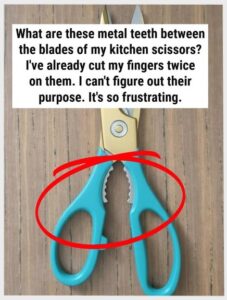Why Your Kitchen Scissors Have That Odd Serrated Section Between the Handles

Most people overlook it, but it’s one of the most useful features on your kitchen shears.
If you’ve ever taken a closer look at the area where your kitchen scissor handles meet, you’ve probably noticed a set of ridged or jagged teeth tucked between the grips. It looks random — almost decorative — and many people never bother to use it. But that little notched section is actually a cleverly designed gripping tool built right into your scissors.
Here’s what it does, and all the ways it can make kitchen tasks easier.
So, what exactly is that toothed part?
You’ll find it right where the handles narrow before meeting the blades. Close the scissors slowly and you’ll see how the ridges interlock, creating a tight, textured grip. This intentional feature might be labeled as a “jar opener,” “nutcracker,” or even “bone grip” depending on the manufacturer.
No matter the name, it’s meant to help you grab onto things your hands can’t hold securely.
1. Opening jars without hurting your wrists
Stuck jar lids are a universal annoyance. That’s exactly where the built-in teeth shine.
How to use it:
-
Close the scissors until the teeth align.
-
Place the jar lid inside that ridged area.
-
Hold the scissors firmly in one hand and twist the jar with the other.
The grooves latch onto the metal lid and give you extra leverage, making tight lids much easier to open. It works especially well for small bottle caps, too — ideal for anyone with reduced grip strength.
2. Cracking nuts without a nutcracker
If you don’t own a nutcracker or can’t find yours, the toothed section steps in as a substitute.
-
Set the nut between the ridges.
-
Squeeze slowly until the shell splits.
-
Rotate and repeat to finish the job.
Just apply pressure gently — you’re trying to fracture the shell, not crush everything inside.
3. Helping break small poultry bones
On sturdy kitchen shears (especially poultry shears), the notched area can help snap thinner chicken bones such as wings or drumette joints.
-
Place the bone in the serrated spot.
-
Apply steady pressure until it pops.
Important: regular, lightweight household scissors aren’t meant for this — you could bend the blades or hurt yourself.
Bonus abilities you probably never knew about
That tiny built-in grip can also help with:
-
Opening stubborn plastic bottle caps
-
Cracking crab legs or lobster shells
-
Loosening soft corks
-
Holding tight onto twist-off seals or slippery packaging
Basically, if your hand slips, the scissor teeth probably won’t.
Why manufacturers add this feature
The goal is simple: to give you a mini multi-tool in a single kitchen item. The integrated gripper can replace or supplement several separate gadgets, making it especially valuable for people with limited drawer space or minimal kitchens.
You’ll most often see it on:
-
Heavy-duty kitchen shears
-
Poultry or bone-cutting scissors
-
Multipurpose utility shears
If the handles have a notched or serrated section that meets when you close the scissors, that’s your clue.
Safety reminders
-
Don’t try to crush hardwood nuts or thick bones — you could damage the tool.
-
Keep fingers clear of the teeth while twisting or squeezing.
-
Clean the ridges thoroughly, especially after raw meat.
-
Avoid using kitchen shears as pliers for non-food items.
A small detail with surprising usefulness
What looks like a simple decorative ridge is actually a hidden helper. By using that serrated section, your scissors transform into much more: a jar opener, nutcracker, seafood cracker, and even a mini bone press.
Next time you grab your kitchen shears, remember — they can do far more than just cut. You just have to take advantage of that overlooked little feature.